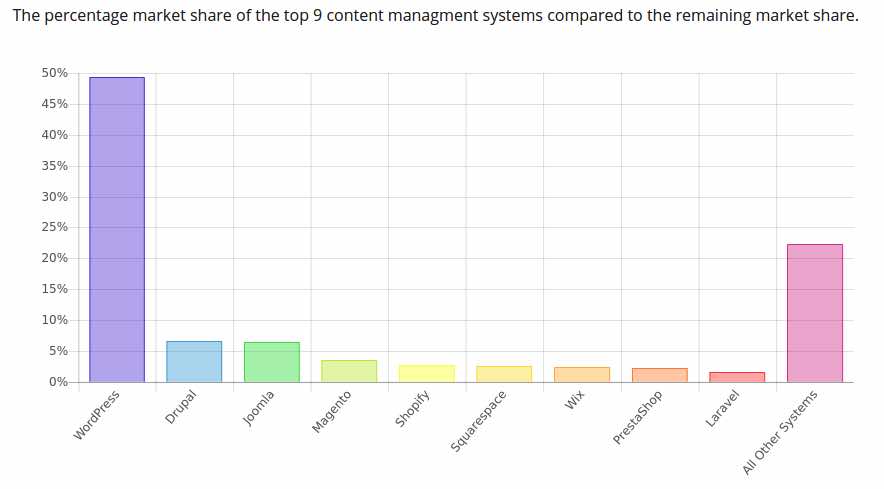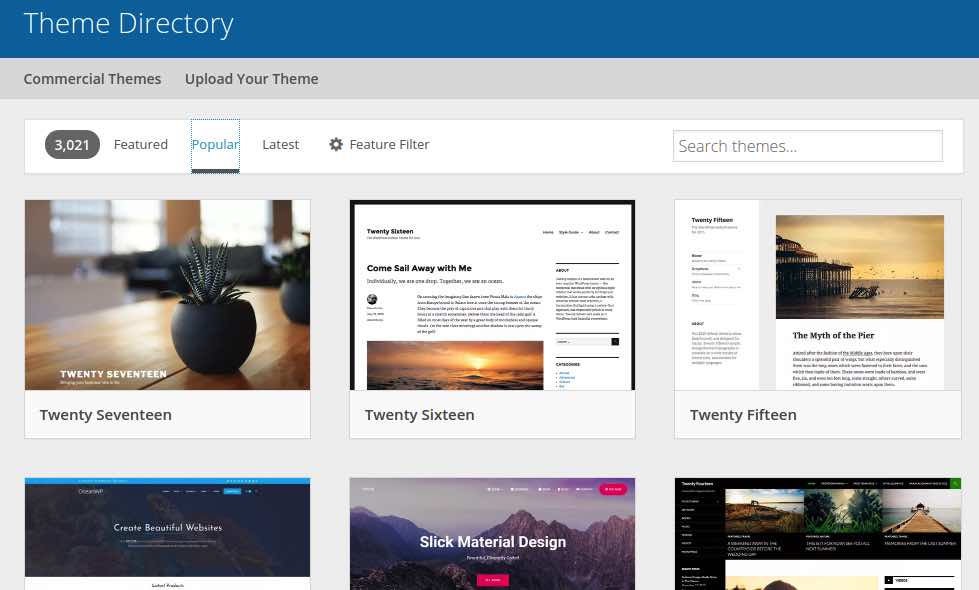Content Management Systems have assisted in reducing the strain one puts in creating a whole website and managing its content.
These systems cater to one’s need of creating a business related website and a personal blog by helping them in organizing and keeping track of both their textual and visual content.
WordPress is one popular content management system that holds around 49% of the market share followed by Drupal, Joomla, and Magento with 6%, 6%, and 3% market share respectively.
These systems cater to one’s need of creating a business related website and a personal blog by helping them in organizing and keeping track of both their textual and visual content.
WordPress is one popular content management system that holds around 49% of the market share followed by Drupal, Joomla, and Magento with 6%, 6%, and 3% market share respectively.

Initially, content management systems focused only on publishing but recently they have shifted to building their own communities and databases as well.
Take Tumblr for instance, this micro-blogging website, which is also regarded as a Content Management System, is simultaneously working as a full-fledged social networking website.
Even Wordpress has its own community where people can read blogs written by other users. Wordpress is so popular that it's now easy to get Wordpress web design services. But still it remains one of those Content Management Systems that people prefer to use mainly because it is an open source, flexible CMS made for everyone and not just the developers -the same reasons why many businesses opt to operate on it. Additionally, make sure to get a good web hosting for Wordpress to help your website perform better in the long term.
The advancement in Content Management Systems has revolutionized how we manage our website and present our business online.
Take Tumblr for instance, this micro-blogging website, which is also regarded as a Content Management System, is simultaneously working as a full-fledged social networking website.
Even Wordpress has its own community where people can read blogs written by other users. Wordpress is so popular that it's now easy to get Wordpress web design services. But still it remains one of those Content Management Systems that people prefer to use mainly because it is an open source, flexible CMS made for everyone and not just the developers -the same reasons why many businesses opt to operate on it. Additionally, make sure to get a good web hosting for Wordpress to help your website perform better in the long term.
The advancement in Content Management Systems has revolutionized how we manage our website and present our business online.

Coding & Themes
Before
Creating a website was a daunting task. Any wrongly coded element could create multiple errors which made the process of coding time-consuming.At the time of redesigning the website, a programmer had to code in the changes made on every single one of the pages.
This not only slowed down the process of running a business related website but also required a great amount of efforts.
After
With Content Management Application, even those with limited expertise are able to add, modify, and remove content on a website without seeking help from a webmaster.So, even with limited technical knowledge you will be able to create and operate your business on the website. The codes, depending on the changes you make on your website, will be handled by the Content Management Systems themselves.
There are a variety of themes, out of which you can choose the one which serves the purpose of your business right. The Content Management Systems will give you a preview of all the pages of the website and apply it to all the pages - themes bring uniformity and are applied automatically.

The Convenience
For handling the working of a website, servers are considered crucial. They help the website perform and process the information in the desired way.
Even a single link break amidst the servers would result in crashing of all of them and eventually the whole website.
There is no need for you to invest in the servers, Content Management Systems only require us to create our website or the blog and craft them with the proper templates and content. All the work that is to be handled by the servers will be taken care of by your chosen Content Management system.
Before
Both the setting up of servers and investing in them was a tough task because the complete process required certain amount of money.Even a single link break amidst the servers would result in crashing of all of them and eventually the whole website.
After
Content Management Systems have their own servers this minimizes the possibility of server related failures allowing your business to run smoothly on the website.There is no need for you to invest in the servers, Content Management Systems only require us to create our website or the blog and craft them with the proper templates and content. All the work that is to be handled by the servers will be taken care of by your chosen Content Management system.
Uploading Content
Every single detail that you experience on a particular website is carefully crafted with codes. Even for uploading and editing of content proper codes are to be entered.
Uploading and editing of visual content was an even harder task. It demanded that you invest a lot of time and concentration because the coding required for the uploading of visual content was comparatively hard than uploading of textual content.
To upload textual content, you are not required to write codes, you need to just write the content in the editor and tap publish. Done. There is a preview option that allows you see how the post will look like before publishing.
Uploading of visual content is not that hard either, some Content Management Systems store the images and videos in their database: like WordPress and some upload it directly from your system: like Stacey.
Uploading visual content takes some time, but publishing it is just as easy as publishing textual content.
Aligning the visual content on the page as needed, is not a tough job either. The Content Management System will generate the corresponding codes.
Before
Uploading of textual content was not that hard but when it came to editing the already published ones, then that was a bit tricky thing to do.Uploading and editing of visual content was an even harder task. It demanded that you invest a lot of time and concentration because the coding required for the uploading of visual content was comparatively hard than uploading of textual content.
After
Content Management Systems allow you to simply post what you have decided to publish.To upload textual content, you are not required to write codes, you need to just write the content in the editor and tap publish. Done. There is a preview option that allows you see how the post will look like before publishing.
Uploading of visual content is not that hard either, some Content Management Systems store the images and videos in their database: like WordPress and some upload it directly from your system: like Stacey.
Uploading visual content takes some time, but publishing it is just as easy as publishing textual content.
Aligning the visual content on the page as needed, is not a tough job either. The Content Management System will generate the corresponding codes.
Tracking The Traffic
Before
Initially, not everyone had the knowledge of tracking user activities. During that time Web Analytics standards were used to track the activities of the users, majorly with the help of caches.This feature provided the detail of the driven traffic and visitors but it required a lot of time for the process to finally conclude and show the results.
After
Tracking the traffic has been made easier too. The Content Management systems tell you from where you have been getting the traffic. In Wordpress, you get the stats about the time when your website was most active. Plus, you will also get a brief account of the locations from where your website is accessed.You can even link Google Analytics with your website and track the traffic more profoundly. With a much more detailed account of from where was the traffic driven and who all have visited your website.
On the basis of the results, you will be able to sell ad spaces on your website and prepare a better marketing strategy for your business.
The Cost Matters Too
Before
Making a website required a hefty investment because more people were to be involved to manage a specific job: the developer, analytics expert, webmaster and more.During this time, big banners like Google, Yahoo, etc. were able to afford such services and the people who have excelled in their area of expertise.
After
Now, creating a website requires a lot of time. The Content Management Systems allow you to create your blog for free and a website too but with a little money investment.So you are not required to invest much money in maintaining your website.
Due to this feature of the Content Management Systems, these are regarded to be best suited for startups. But big banners like BBC America and Sony Music have their website running on Content Management systems.
Control & Application
Before
When all set to publish a new post, before Content Management Systems, you could only do it via a PC or a laptop, even for the editing purposes too.Also, there was a single login with password, whosoever had it was able to access everything that the website had to offer.
After
With Content Management Systems, you can assign access to the specific people who are required to act upon their field of work. You can assign the publishing rights to a specific person, you can assign people the rights to edit posts, manage comment, etc.Many Content Management Systems have their respective applications, after accessing them you will be able to check the traffic on your website, publish posts on your website, and reply to comments anytime, anywhere.
Bonus For Content Management Systems Users:
For better optimization and better functionality of your website, Content Management Systems allow you to install plugins to broaden their area of work and provide you with better optimization.
Every Content Management System has their respective plugins and most of them allow you to even install third party plugins.
The most popular of the Content Management Systems are Wordpress, Drupal, Webflow, Shopify and Joomla. Now, what are the plugins which can be used as an add on service alongside famous Content Management Systems to improve their functionality;
Akismet – It constantly keeps track of the comments and submissions made on your website and filters out those which appear to be spam.
Yoast SEO – It is an effective SEO plugin which works to improve the SEO of your website plus it prevents duplicate content.
Pro tip: How to create a sticky menu on any Wordpress website.
Drupal Testimonials Simple Block – Through this plugin you are provided with customizable blocks for testimonials.
Team Showcase for Drupal – This plugin allows you to showcase team, members, staff, etc. in responsive grids or tables.
Spinner 360 – It manages the images and allows them to rotate 360 degrees from module.
Canonical URL – This plugin profoundly helps in managing duplicate URLs.
Every Content Management System has their respective plugins and most of them allow you to even install third party plugins.
The most popular of the Content Management Systems are Wordpress, Drupal, Webflow, Shopify and Joomla. Now, what are the plugins which can be used as an add on service alongside famous Content Management Systems to improve their functionality;
For Wordpress:
bbPress – This plugin allows you to add safe, easy to use, and fast forums and bulletin boards to your website.Akismet – It constantly keeps track of the comments and submissions made on your website and filters out those which appear to be spam.
Yoast SEO – It is an effective SEO plugin which works to improve the SEO of your website plus it prevents duplicate content.
Pro tip: How to create a sticky menu on any Wordpress website.
For Drupal:
Twitter Feed & Slider – It notifies you about the constant updates on your twitter feed be it retweets, replies, everything.Drupal Testimonials Simple Block – Through this plugin you are provided with customizable blocks for testimonials.
Team Showcase for Drupal – This plugin allows you to showcase team, members, staff, etc. in responsive grids or tables.
For Joomla:
Flexible Form – The plugin is used to create forms and fields and further export them to CSV format.Spinner 360 – It manages the images and allows them to rotate 360 degrees from module.
Canonical URL – This plugin profoundly helps in managing duplicate URLs.
So, how content management systems (CMS) changed the way to do business
Content Management Systems ease the workload and allow you to concentrate more effectively on other aspects of your website. And with them being a much more convenient and affordable medium, smaller businesses will be able to compete with bigger ones. The advanced features of Content Management Systems will allow you to manage your website and your business in a far better and convenient way than the previous modes.Growth Hackers has been recognized as one of the top Wordpress web design companies. Therefore, there is no doubts we can help your business build a beautiful website. At Growth Hackers, we help businesses shine with high-converting web designs, great UX, digital marketing and growth hacking. Our favorite CMS is Wordpress (We have experienced, in-house Wordpress consultants) and our second favorite is Shopify (For e-commerce, it's actually our favorite. But, we also have experience with Joomla, Wix, Webflow, SquareSpace and Drupal. Contact Growth Hackers right away if you want to improve your website, make it more-conversion focus and start building a digital lead generation machine.





1 Comment
Hello, Admin Although I am not so keen on reading the whole blog, this one got me. Your presentation of ideas and guidance is amazing.